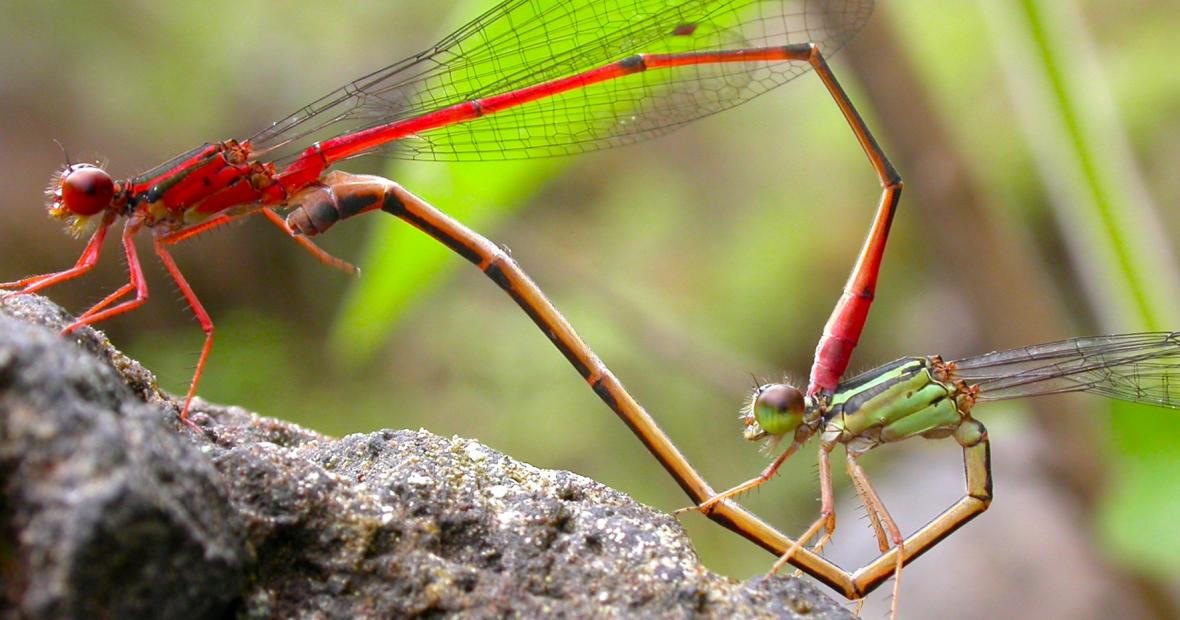Big Island Summer
Rebecca Rasmussen ’16 and Edward Hsieh ’16 helped find what turned out to be the largest super colony of ants ever recorded in North America. By large, we mean all the way from Iowa to the Appalachian Mountains.
Those Mentored Advanced Projects (MAPs) in summer 2014 earned them both an invitation from Grinnell biology professor Jackie Brown to do a second MAP last summer. This one meant spending two months on Big Island, Hawaii.
Both students agreed enthusiastically. By mid-May, Rasmussen and Hsieh were planning preliminary field studies to help Brown and Idelle Cooper ’01 of James Madison University find out why some female damselflies are red and some are green.
Ecological or sexual selection
“I was looking at a behavioral biology aspect because we wanted to see if the females were evolving this color dimorphism because of sexual selection,” Rasmussen says. For two months, she and other researchers stalked damselflies at various sites near Na’alehu, the southernmost town in the United States.
“Our main hypothesis was ecological selection, so I was testing the alternative,” Rasmussen says. Her findings indicated that sexual selection was minimal. “What we saw goes along with what Professor Brown and Professor Cooper have been positing, which is promising for their research,” she says.
Hsieh tested for chemical properties related to the color morphs. “In the ant project I looked at their particular hydrocarbons, and in this one I looked at antioxidant chemicals to see what potentially helped protect damselflies against UV radiation depending on the elevation.”
Finding the unexpected
Hsieh’s early findings contradicted expectations that red pigment signals protection from UV stress. He found that the redder the damselfly, the lower its antioxidant capability. “We have a couple of theories as to why that might be so,” Hsieh says. “It’s still pretty open ended and we’re actually continuing to work on it right now.”
Brown, who along with Cooper received National Science Foundation funding for the damselfly project, says, “Working with Edward and Rebecca on two different projects has highlighted for me both their talents and the value of our research-based curriculum in preparing students for meaningful participation in research.
“Each has built on their particular experience with the ant project, but in a completely new setting,” Brown says. “We’ll be working hard together during their senior year to submit these results for publication.”
Serious contributions
Rasmussen says the collaborative research processes have made her feel “more prepared for going to graduate school in biology, if that’s the route I decide to take. Going through the planning stage, executing it, and then summarizing it is, I think, applicable to any career field.”
Rasmussen says it is satisfying as an undergraduate to do research that adds knowledge to a field. “It is pretty exciting to find things that could seriously contribute or that turn out to be an unusual finding that is worth reporting,” she says.
“I was originally interested in doing biological field research,” Hsieh says of his MAP experience, “and these opportunities gave me a lot of experience in what I would expect to do if I were to continue in that vein. It’s very likely that I’ll continue on to graduate school, possibly in entomological research.”
Coolest experience
Damselfly research is highly weather dependent, so on a few rainy days the research team found diversions that included Hawaii’s vast mix of Asian cuisine, volcanoes, and black sand beaches.
“One morning it was pretty rainy so we went to a beautiful beach for snorkeling,” Hsieh says. “We swam with sea turtles, and then farther out we found a giant pod of 30-plus dolphins.
“We were swimming with dolphins,” Hsieh says. “It was one of the coolest experiences of my life. And it was on my 21st birthday. It was awesome.”
Rebecca Rasmussen ’16 is a biology major from Des Moines, Iowa. Edward Hsieh ’16 is a biology major from Champaign, Ill.

